The Economics and Statistics Division maintains archives of previous publications for accountability purposes, but makes no updates to keep these documents current with the latest data revisions from Statistics Canada. As a result, information in older documents may not be accurate. Please exercise caution when referring to older documents. For the latest information and historical data, please contact the individual listed to the right.
<--- Return to Archive
For additional information relating to this article, please contact:
May 23, 2018HOURS WORKED AND LABOUR PRODUCTIVITY, 2017 [PRELIMINARY] Statistics Canada has released preliminary labour productivity accounts for the provinces for 2017, no revisions to data for previous years was made. The data is consistent with the preliminary GDP by industry estimates released on May 2, 2018.
In 2017, Nova Scotia's labour productivity in the business sector increased by 2.3 per cent following growth of 1.5 per cent in 2016 and 2.1 per cent in 2015. Canada's labour productivity in the business sector increased 2.2 per cent in 2017, following an increase of 0.6 per cent in 2016 and a decline of 0.4 per cent in 2015. In Nova Scotia, 35.6 dollars (chained 2007) of GDP are produced per hour of work. Nationally, labour productivity is 51.1 dollars per hour.
In Nova Scotia, 2.3 per cent growth in real labour productivity is the result of 1.4 per cent growth in real value added while hours worked were down 0.8 per cent. In Canada, 2.2 per cent growth of real labour productivity reflects real output growth of 3.8 per cent while hours worked increased by 1.5 per cent.
Labour productivity rose 3.1 per cent in Nova Scotia's services-producing sector, while productivity in the goods-producing sector rose 0.2 per cent. In Canada, productivity rose in the goods-producing sector by 2.7 per cent and the services-producing sector was up 2.1 per cent.


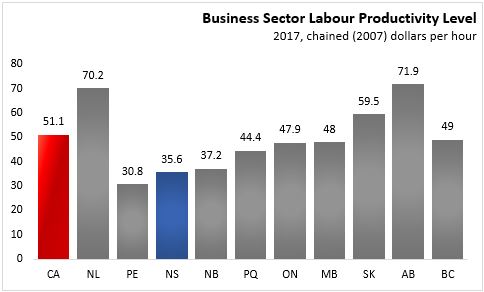
Business sector productivity increased in nine provinces in 2017. Prince Edward Island was the only province to report a decline in labour productivity, after reporting large gains in 2015 and 2016, as growth in hours worked outpaced growth in real output. Newfoundland and Labrador had the strongest labour productivity growth at 9.2 per cent.
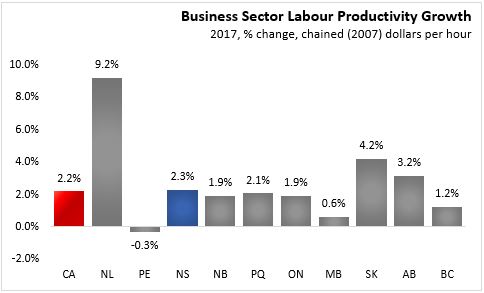
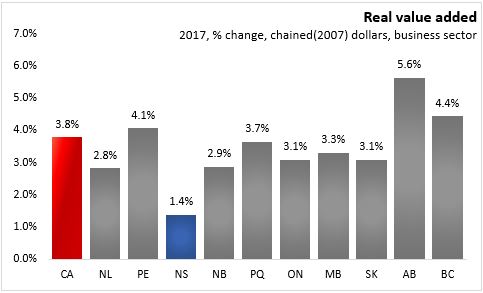
Hours worked in the business sector rose in seven provinces in 2017. Prince Edward Island had the fastest growth in hours worked, following declines in 2015 and 2016. Newfoundland and Labrador had the largest decline in hours worked, with hours falling in every major industry sector except utilities, real estate, and mining, quarrying, oil and gas extraction. Hours worked fell 0.8 per cent in Nova Scotia - the fifth consecutive annual decline.

Compensation per hour of work in the business sector was up 3.5 per cent in Nova Scotia to $26.08. Total compensation for business sector industries was up 2.6 per cent while hours worked were down 0.8 per cent. Compensation per hour worked was up in eight provinces, with Prince Edward Island and Alberta reporting declines. Compensation per hour of work increased 2.1 per cent in Canada in 2017.
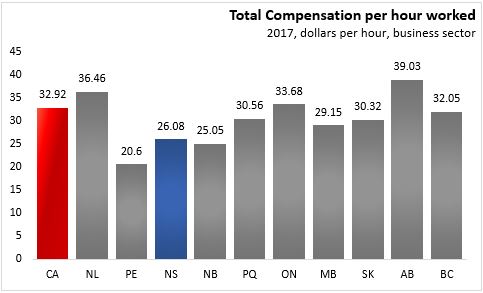
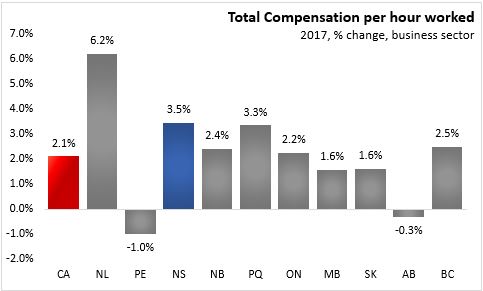
With compensation per hour worked (+3.5 per cent) rising faster than labour productivity (+2.3 per cent), the unit labour cost (dollars per unit of real GDP) was up in Nova Scotia by 1.2 per cent in 2017. Unit labour costs were up in six provinces, with Nova Scotia, Quebec and British Columbia growing the fastest at 1.2 per cent. The Canadian average declined 0.2 per cent, with Alberta reporting the largest decline in percentage terms. Unit labour costs in US dollars were up in seven provinces, with declines in Alberta, Newfoundland and Labrador, and Saskatchewan.
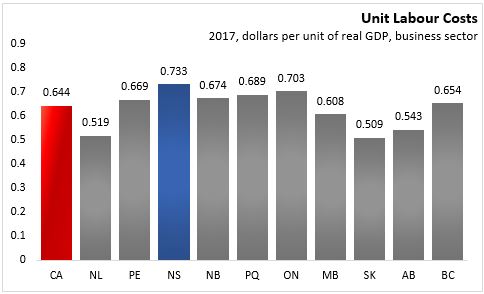
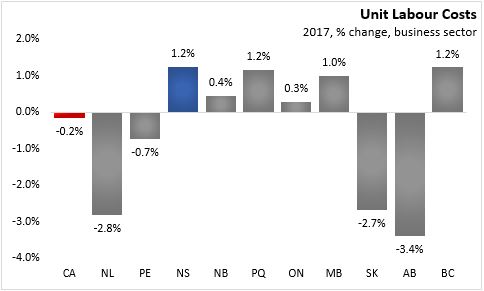

Within Nova Scotia, labour productivity of goods sector was up 0.2 per cent with increases in construction (+3.8 per cent), manufacturing (+3.0 per cent), and utilities (+2.5 per cent) and decreases in mining, oil and gas extraction (-30.1 per cent), and agriculture, forestry, fishing and hunting (-4.8 per cent). Services sector labour productivity increased 3.1 per cent in 2017 with productivity rising in every subsector except accommodation and food services, which declined 3.1 per cent.
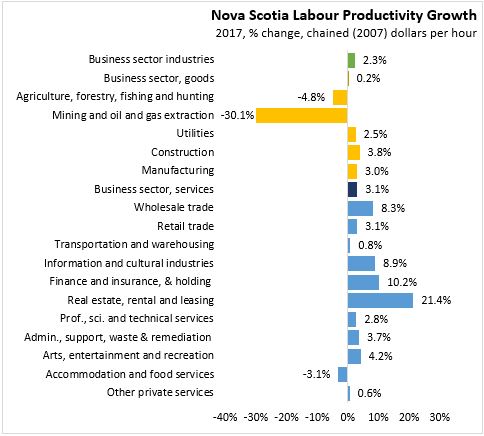
Source: Statistics Canada, CANSIM 383-0033
<--- Return to Archive